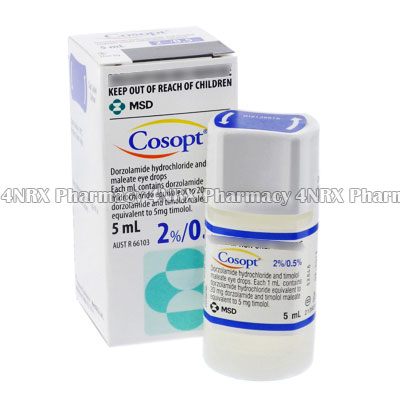 |
Home  Eyes Eyes  Cosopt (Timolol Maleate/Dorzolamide Hydrochloride) Cosopt (Timolol Maleate/Dorzolamide Hydrochloride) |
|
|||||||||
|
|
Cosopt (Timolol Maleate/Dorzolamide Hydrochloride)
What is Cosopt (Timolol Maleate/Dorzolamide Hydrochloride) used for? Cosopt (Timolol Maleate/Dorzolamide Hydrochloride) is an ophthalmic medication used to treat patients suffering from open angle glaucoma or pseudo-exfoliative glaucoma. It lowers the amount of fluid in the eye to alleviate pressure and reduce symptoms associated with this condition such as pain, loss of vision, or potential damage to the optic nerve. Your physician may also prescribe it to treat other conditions that are not listed here. How should I use Cosopt (Timolol Maleate/Dorzolamide Hydrochloride)? Always follow the instructions provided by your physician while using Cosopt (Timolol Maleate/Dorzolamide Hydrochloride) to get the best results. The typical dosage is one drop administered each day, but your particular instructions may differ based on the condition being treated, your current health, and the severity of your symptoms. Wash your hands before using the medicine to remove any contaminants or dirt. Gently shake the bottle before application to mix its contents and observe the solution to make sure it is not cloudy or discolored as this may indicate contamination. To use the medicine tilt your head back slightly, pull down the lower lid of the eye being traeted, hold the bottle over the eye, and dispense one drop into the pouch that is formed. Slowly close the eyelid to spread the medicine and keep the eye closed for ten seconds allowing the medication to be absorbed. Never allow the tip of the bottle to touch any foreign surfaces, including the eye itself, to prevent contamination. It is also suggested to wash your hands after each administration to prevent the solution from contacting areas not being treated or the mucous membranes. Ask your physician any questions you have about the medicine to ensure the correct administration. What are the side effects of Cosopt (Timolol Maleate/Dorzolamide Hydrochloride)? The use of Cosopt (Timolol Maleate/Dorzolamide Hydrochloride) may cause side effects in some patients including:
More serious symptoms that may require medical attention include severe pain or redness of the eye, intense swelling of the eyelid, trouble breathing, unusual swelling in the hands or feet, crusting, discharge from the eye, or a severe skin rash. Always inform your physician about any symptoms you encounter that are worrying or intense to make sure the correct alterations are made to your regimen to prevent further problems. This may include reducing your dosage or frequency of administration. Please Note Remove your contact lenses before using Cosopt (Timolol Maleate/Dorzolamide Hydrochloride) as they may cause unexpected complications. Do not begin using the medicine if you are pregnant, breastfeeding, or have uncontrolled heart failure, asthma, chronic obstructive pulmonary disorder (COPD), circulation problems, sinus bradycardia, 2nd or 3rd degree heart block, acidosis, or severely decreased kidney function. Also disclose if you have had eye surgery, defects of the cornea, hypotension, history of heart disease, angina, diabetes, psoriasis, myasthenia gravis, hyperthyroidism, peripheral arterial disorders, history of kidney stones, or decreased liver function. These conditions may cause unexpected problems requiring reduced dosages or other alterations to your regimen. Strictly follow all instructions provided to you by your physician or pharmacist while using Cosopt (Timolol Maleate/Dorzolamide Hydrochloride). Optimum and safe dosage can differ based on the patient and the condition being treated. As this medication may be unsafe for certain patients, it is essential you always inform your physician if you are pregnant or breastfeeding, as well as if you have any allergies, other illnesses, or ongoing health conditions, and if you are taking any other form of medication, supplements, or herbal products. Immediately seek emergency medical care if you have an allergic or hypersensitive reaction. Common signs of a reaction include hives, swelling, skin rashes, chest pains, as well as trouble breathing or swallowing. 
|
||||||||||||||||||||||